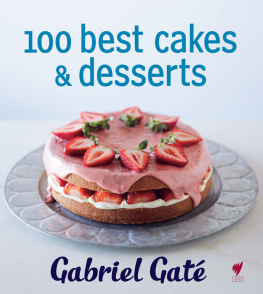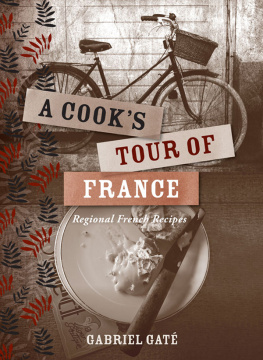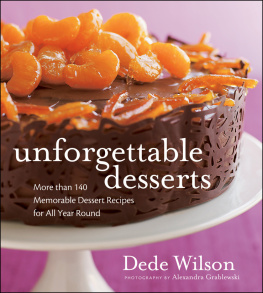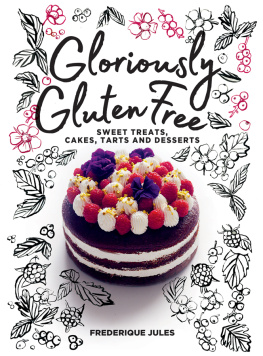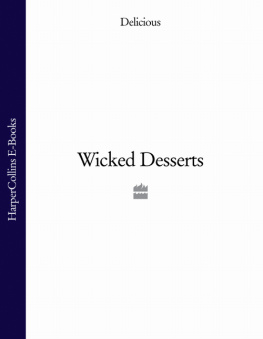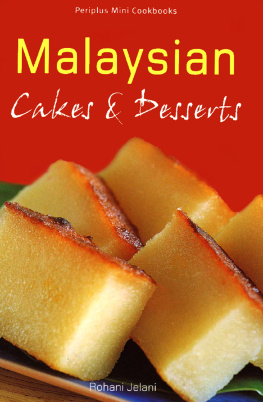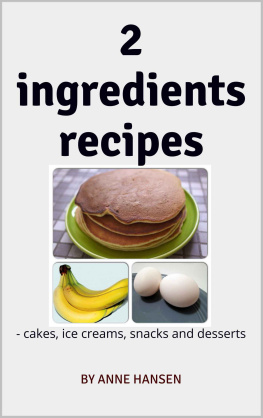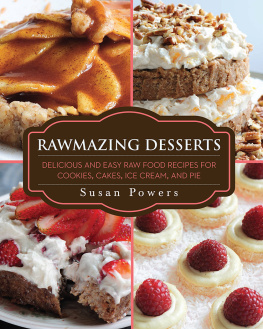contents
Mangoes and cherries, chocolate cake and pavlova, rhubarb and raspberries, meringues and fruit tarts, trifles and mousses, crpes and passionfruit souffl I love desserts and have enjoyed making them since I was a child.
Growing up in the Loire Valley in France, we had more than fifty fruit trees in our garden and small family vineyard. Among other things, my parents grew raspberries, strawberries, rhubarb and redcurrants, and we often went out in search of wild blackberries, wild strawberries, hazelnuts, walnuts and chestnuts.
We lived with my maternal grandmother, who was the queen of the kitchen, making glorious cakes, fruit tarts and superb family desserts, like crpes and custards. My very first kitchen memory is helping her make an apple tart when I was about five years old.
My grandmother was a delight to be with. From her I learned the love of cooking. And from my mum I learned the joy of eating. Not surprisingly, my eldest brother became a ptissier/boulanger (pastrycook/baker) and I became a cuisinier/ptissier (chef/pastrycook). I trained forty years ago with the best Master Chef of my generation and after some solid experience in restaurants I began to freelance, concentrating on teaching, writing and presenting recipes and cooking shows on television.
Most of my work over the last twenty-five years has focused on home cooking. There is something really special about homemade cakes and desserts, about using the best seasonal fruits, and learning to make pastries and other sweet concoctions. Dessert-making is an exciting and creative hobby. Its a satisfying way to spend an hour or two in the kitchen, and your family and friends will love you for it. Most home cooks have a repertoire of about half-a-dozen desserts. If you try a new dessert every month, youll have made more than one hundred and twenty new desserts over ten years and youll be a great cook!
When baking, you need to carefully measure the ingredients. I use measuring cups and spoons as well as digital scales. My most prized piece of equipment is my electric mixer, which has a large bowl and a whisk attachment to beat egg whites and to cream eggs and sugar. It also has a beater attachment for mixing pastry and for creaming butter and sugar. Use good-quality ingredients cakes, pastries and desserts taste better when made with fresh eggs, butter and flour, and the sweetest, freshest fruits.
Involve your children in making your desserts. And be easy on yourself if your first try at a new recipe is not perfect, you will usually master it after a second or third attempt.
I hope this book brings much pleasure to you and your family.
Best wishes,

Baked Lemon Cheesecake
SERVES 12
People of all ages love this light baked cheesecake. Bake it at least 4 hours before serving, and store it in the fridge if you plan to serve it much later than that.
180 g (6 oz) plain sweet biscuits (cookies)
125 g (4 oz) butter, melted
40 g (1 oz/ cup) raw almonds, very finely chopped
400 ml (13 fl oz) milk
60 g (2 oz) unsalted butter
60 g (2 oz/ cup) cornflour (cornstarch)
2 egg yolks
350 g (12 oz) cream cheese
juice of 2 lemons
5 egg whites
pinch of cream of tartar
145 g (5 oz/ cup) caster (superfine) sugar
icing (confectioners) sugar, for dusting
Preheat the oven to 150C (300F). Butter a 24 cm (9 in) springform cake tin.
Place the biscuits in a food processor and process until they have the consistency of raw sugar. Using a wooden spoon, combine the biscuit crumbs, melted butter and chopped almonds. Press the crumb mixture into the prepared tin, covering two-thirds of the side of the tin. Refrigerate while preparing the filling.
Place 350 ml (12 fl oz) of the milk and the unsalted butter in a saucepan and bring to the boil. Combine the cornflour, egg yolks and remaining milk in a bowl. Mix into the hot milk mixture and cook over low heat, stirring occasionally, for 5 minutes. Remove from the heat, stir in the cream cheese, add the lemon juice and mix until smooth.
Using electric beaters, beat the egg whites and cream of tartar until stiff peaks form. Gradually add the sugar and beat until the egg whites are firm. Gently fold the beaten egg whites into the cream cheese mixture.
Pour the filling onto the chilled crumb mixture, smooth the top and bake for 1 hour 20 minutes or until the centre is set. Set aside to cool completely, then remove from the tin and refrigerate.
Remove the cheesecake from the refrigerator 20 minutes before serving. Serve dusted with a little icing sugar.

Apricot and Hazelnut Dacquoise
SERVES 10
For this recipe you can prepare the meringues and the apricot pure a day ahead, and assemble the dacquoise just before serving.
60 g (2 oz/ cup ) ground hazelnuts, toasted
1 tablespoon cornflour (cornstarch)
180 g (6 oz) caster (superfine) sugar
4 large egg whites
pinch of cream of tartar
teaspoon vinegar
teaspoon pure vanilla extract
80 g (3 oz) dried apricots
375 ml (13 fl oz/1 cups) cream, whipped until firm
20 roasted hazelnuts, chopped
90 g (3 oz/1 cup) flaked almonds, toasted
icing (confectioners) sugar, for dusting
Preheat the oven to 180C (350F). Draw a 20 cm (8 in) circle on three sheets of baking paper and use them to line three baking trays.
Combine the toasted ground hazelnuts, cornflour and one-quarter of the sugar.
Using electric beaters, beat the egg whites and cream of tartar on medium to high speed until almost stiff. Reduce speed to low, gradually add the remaining sugar, then the vinegar and vanilla extract, and beat until stiff peaks form.
Fold the ground hazelnut mixture into the beaten whites. Spoon the mixture into a piping bag fitted with a 1 cm ( in) plain nozzle. Pipe three discs inside the circles on the baking paper, starting from the outside and moving inwards to fill the inside of the discs. Bake the discs for 2530 minutes or until the meringue is firm and dry. Set aside to cool.
Place the dried apricots in a saucepan and cover with cold water. Bring to the boil, then cook for 10 minutes. Drain the apricots and blend to a fine pure. Set aside to cool.
Spread two meringue discs with apricot pure, then top with two-thirds of the whipped cream and sprinkle with the chopped hazelnuts. Stack the meringue discs, placing the plain one on top. Spread the remaining cream over the side of the dacquoise and lightly press on the flaked almonds. Dust the top with icing sugar and serve.
Orange and Almond Cake
SERVES 810
Make this flourless cake in the winter months when oranges are at their best. The first step is quite unusual as you need to simmer two whole oranges in water for 2 hours. After that, its a piece of cake!
2 unblemished oranges
235 g (8 oz/1 cups) blanched almonds
230 g (8 oz/1 cup) caster (superfine) sugar
5 large eggs
1 teaspoon baking powder
icing (confectioners) sugar, for dusting
Wash the oranges and place in a saucepan. Cover with cold water and bring to the boil, then cover the pan and simmer for 2 hours. Top up the water during cooking when necessary. Drain the oranges and set aside to cool.

